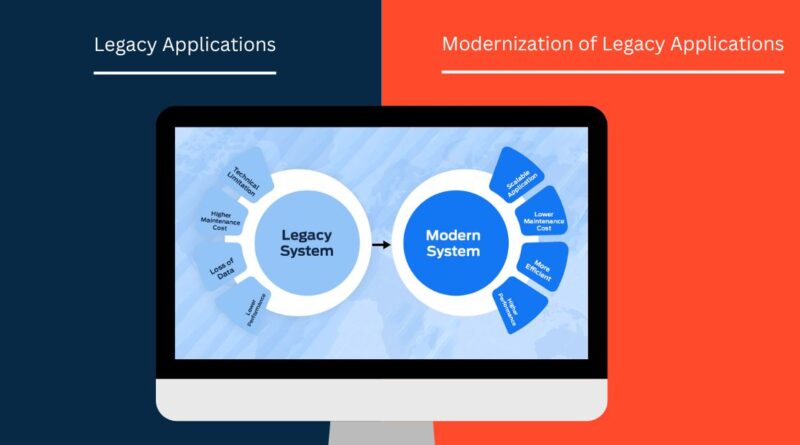6 Proven Steps for Modernization of Legacy Applications
Enterprises are highly dynamic, adapting and evolving to align their services to meet market demands. To manage day-to-day operations and stay competitive, enterprise applications need rapid enhancements. Fiercely transforming enterprises with innovative business models can not rely on legacy applications.
Legacy applications are outdated applications running on obsolete architectures. Although capable of working, these applications lose enterprise-level efficiency in the upcoming years. They lack innovative solutions and top-notch data security protection. That’s when the power of application modernisation services comes into the picture.
This article discusses the steps to legacy software modernisation.
Define the Business Case
Defining the business case behind undertaking a project is essential to orient the stakeholders. This documents the business vision, purpose, and rationale. Also, it allows the stakeholders to monitor the project throughout its lifecycle. Analyzing a business case enables the staff, teams, developers, project managers, and C-level executives to measure their investments and benefits in a documented manner. This is important to deter methods and integration that may incur a low ROI, cost risks, complexity, security, and compliance risks before contemplating legacy system modernization services.
Assessment of Legacy Application
Assessing legacy applications and their components for outdated performance helps organizations to understand which component of a legacy application is not meeting the competitive demands of business and needs a replacement. If technology does not allow the business to grow in the upcoming years, it must be modernized to keep the organization in the dynamic digital landscape.
Prioritise Areas for Modernisation
Enterprises vary in their terms of performance. For instance, for some, the worker’s productivity is more important. For others, it may be security and compliance issues. Analysing the key areas where upgraded technology gives more returns on investments should be prioritized. Ensuring the application modernization, be they security consolidation or cloud application modernization, should add value to the business operations.
Businesses may put forth questions like,
- Is the core business service dependent on the legacy systems?
- What business component is most impacted by the modernization?
- What are the core strengths and weaknesses of the business?
- What are the risks associated with application modernization services?
- What integrations and infrastructure should be adopted?
These queries help stakeholders intervene and stay on top of information important to them.
Adopt a Modernisation Strategy
After finding the important areas to improve and upgrade, adopting a legacy application modernization strategy is significant to initiate the process. Once the strategy is finalized, a business understands how to proceed in the right direction. Selecting the most suitable application modernization strategy that suits the business needs is important.
Multiple techniques for modernization are available. Depending upon the resources, training, and time utilization, businesses can make a propitious decision of application modernization solutions. Some of the techniques are elaborated below.
Rehosting: Move current applications to a modern environment with the least code changes.
Refactoring: Writing or improving code for better performance and maintainability.
Replatforming: Minor codebase adjustments before migrating to the modern platform.
Rearchitecting: Transforming the architecture, creating microservices, and serverless computing.
Replacing: Completely replacing the existing architecture with better solutions.
Hybrid Approach: Involves multiple and specific approaches throughout the application.
DevOps and CI/CD: Automating development, testing, deployment, and implementing best practices.
Incremental Modernisation: Gradually modernizing every component of an application.
Monitoring the Roadmap
Businesses gain insights about the pace of modernization with a roadmap and consistent monitoring. Managing schedules and analyzing the milestones help determine the project’s success and timeline. This also briefs about the milestones that must be accomplished by the end of the project’s lifecycle. For instance, modernising the application is not the only goal of the enterprise, but the value that comes from it.
Important factors to analyze in the roadmap are:
Agile Approach: Adopting an agile approach helps make the transition smooth and predictable.
Schedules and Overview: Regular sprints, preferably a 2-week sprint, help businesses expect iterative and incremental delivery of the project.
Dependencies: Documenting dependencies helps enterprises identify the modernization bottlenecks and how to resolve them.
Budget and Resourcing: Budgeting and resource allocation are important in development, testing, and deployment.
Implementing Specific Technologies
Relying on untested and niche technologies, opting for industry-specific technologies is more reasonable.
Some implementation tips are discussed below.
Cloud-native Approach: Adopting AWS Quicksight for more agility and extensibility to speed up the development.
Industry-specific Technologies: Technologies and platforms that are industry-specific should be used for application modernization.
Adopting Agile Approach: Agile helps businesses to maintain effective collaboration, flexibility throughout the project, and on-time delivery.
Refer to the roadmap: A roadmap allows enterprises to accomplish their goals and meet their objectives within the said deadlines.
Find a trustworthy tech partner. A knowledgeable IT partner can meet business expectations and assist in modernizing legacy applications.
Conclusion
Legacy application modernization enables businesses to increase their work efficiency and adapt to emerging technologies to lead the competition. As the digital landscape is evolving faster than ever, modernized applications enable businesses to integrate emerging and latest technologies to provide custom-centric solutions and drive immense revenue from the fast-paced digital incarnation.

